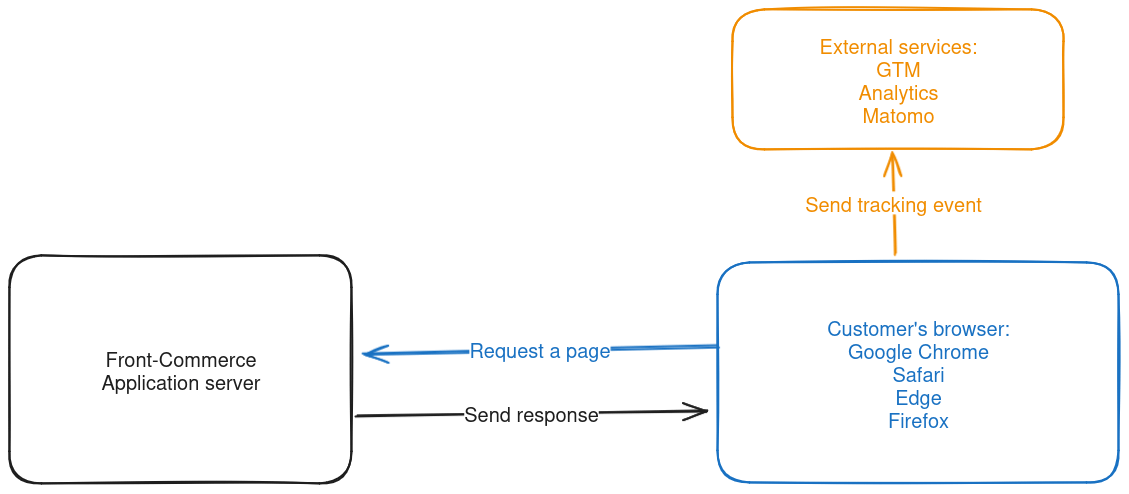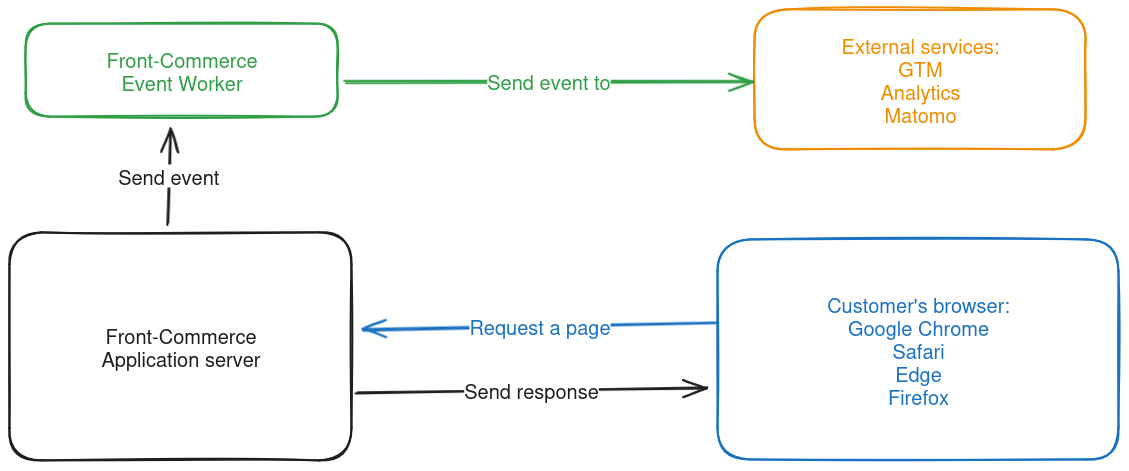Are you concerned about the accuracy of your website data due to privacy restrictions and ad blockers? Traditional methods of collecting data through browser-based scripts, known as client-side tracking, are facing increasing limitations. This guide explores server-side tracking, a powerful alternative that ensures reliable data collection, enabling you to make informed decisions about your business.
As privacy regulations tighten and the use of ad blockers grows, client-side tracking often results in incomplete or inaccurate data. These challenges hinder effective marketing and analytics efforts. Server-side tracking emerges as a solution to overcome these obstacles by collecting data directly from the server. This method circumvents ad blockers and browser restrictions, ensuring higher data accuracy and reliability. Additionally, it enhances data quality and addresses privacy concerns by avoiding the exposure of sensitive information on the client side.
The Rise of Server-Side Tracking
Growing privacy regulations and the decline of third-party cookies are rendering traditional client-side tracking unreliable. Server-side tracking offers a reliable solution by capturing data directly on the server, bypassing limitations imposed by user browsers.
Server-side tracking addresses privacy concerns by collecting data on the server rather than through client-side scripts in the user’s browser. This approach enhances privacy and security in several ways:
- Circumventing Ad Blockers and Browser Restrictions: Server-side tracking ensures more accurate and complete data capture by avoiding ad blockers and browser settings that limit or prevent client-side data collection.
- Enhanced Data Privacy: By keeping user data on the server, server-side tracking avoids exposing sensitive information on the client side, reducing the risk of data breaches.
- Control Over Data: Website owners have complete control over the collected data, defining precisely what is shared with third-party platforms like analytics tools or ad networks. This ensures compliance with data privacy regulations such as GDPR and HIPAA.
Server-side tracking also sets first-party cookies that can only be read by the website’s server, making them more secure than client-side third-party cookies vulnerable to cross-site scripting attacks. Overall, this server-based approach provides a secure way for marketers to respectfully collect and utilize online customer data in an era of heightened privacy awareness.
By understanding and implementing server-side tracking, businesses can enhance their data accuracy, comply with privacy regulations, and optimize their marketing and analytics strategies. Read on to find out more about server-side tracking.
Client-Side vs. Server-Side Tracking
Client-Side Tracking
- Relies on user browsers to collect data through client-side scripts like JavaScript, making it vulnerable to factors like ad blockers and restrictive privacy settings that can block or limit data collection.
- Exposes sensitive user data on the client side, increasing the risk of data breaches and privacy violations.
- Offers limited control over the collected data, as third-party trackers like pixels and cookies dictate what information is gathered.
Server-Side Tracking
- Captures data directly on the server, guaranteeing complete and accurate collection regardless of browser settings, ad blockers, or user preferences.
- Keeps user data secure on the server side, reducing the risk of exposing sensitive information and enhancing privacy compliance.
- Gives website owners full control over the collected data, allowing them to define precisely what information is shared with third parties and redact sensitive details if needed.
- Circumvents limitations of third-party cookies by setting first-party cookies that are more secure and can only be read by the website’s server.
- Ensures faster website loading times by eliminating the need to load external tracking scripts in the user’s browser.
By addressing the weaknesses of client-side tracking, server-side tracking emerges as a solution that prioritizes data accuracy, privacy, and control in the face of increasing user concerns and regulatory changes.
Client-side tracking diagram
Let’s take a closer look at how client-side tracking is set up in your system.

Server-side tracking diagram
And now if we look at the schema below we can see how server-side tracking fits into your system more clearly.

Unlocking the Benefits of Server-Side Tracking
By addressing data privacy concerns, improving data quality, enabling event-driven actions, and ensuring cross-platform compatibility, server-side tracking emerges as a powerful solution for businesses seeking to enhance their digital marketing and analytics efforts.
Data Integrity
Enhanced Data Privacy: Server-side tracking aligns with evolving data privacy regulations by minimizing the collection of personal information on the client side. Website owners have full control over what data is shared with third parties, allowing them to redact sensitive details and ensure compliance with laws like GDPR.
Improved Data Quality: By circumventing ad blockers and browser restrictions, server-side tracking provides a more accurate and comprehensive representation of user behavior on your website. This leads to better data completeness and quality for analysis.
Event-Driven Actions
Server-side tracking enables personalized actions based on user behavior, such as abandoned cart reminders or product recommendations. By capturing data directly on the server, it can trigger real-time responses tailored to individual user journeys.
Cross-Platform Compatibility
Server-side tracking monitors user behavior across different devices and browsers, offering a holistic view of the customer journey. This cross-platform compatibility ensures consistent experiences and accurate data collection, regardless of the user’s device or browser.
Get a more technical view of server-side tracking and server side events in Front-Commerce by diving into our documentation
Why and How to Switch to Server-Side Tracking
Addressing Privacy Concerns
Server-side tracking helps businesses comply with data privacy regulations like GDPR by minimizing the collection of personal information on the client side. It gives website owners full control over the data shared with third parties, allowing them to redact sensitive details like IP addresses and ensure compliance. By keeping user data secure on the server, it reduces the risk of exposing sensitive information and enhances privacy.
Benefits for Businesses
- Improved Data Quality: Server-side tracking circumvents ad blockers and browser restrictions, providing a more accurate and comprehensive representation of user behavior, leading to better data completeness and quality for analysis.
- Enhanced Marketing Effectiveness: With accurate data, businesses can make informed decisions about marketing strategies, product development, and customer experience optimization based on a holistic view of the customer journey across devices.
- Better User Experience: Server-side tracking enables faster website loading times by reducing the need to load external tracking scripts in the user’s browser, improving site performance and search engine rankings.
Transitioning to Server-Side Tracking
While setting up server-side tracking requires technical expertise in areas like server-side containers and data processing, the process is relatively straightforward compared to traditional methods. Once implemented and properly tested, server-side tracking can seamlessly collect data without disrupting the user experience.
Given the strategic importance of server-side tracking, businesses should consider partnering with experienced agencies that specialize in this area to ensure a smooth transition and effective implementation aligned with their data strategy and compliance requirements.
Conclusion
Server-side tracking offers a future-proof solution for data collection in today’s privacy-conscious environment. By leveraging this innovative approach, businesses can gain deeper customer insights and make data-driven decisions that lead to long-term success.
As privacy concerns and regulatory changes grow, server-side tracking enables businesses to enhance their digital marketing and analytics efforts. This method ensures data accuracy, privacy compliance, and control over the information shared with third parties, making it a robust alternative to traditional client-side tracking.
The benefits of server-side tracking, such as improved data quality, event-driven personalization, and cross-platform compatibility, drive informed decision-making, effective marketing strategies, and optimized customer experiences. With client-side tracking becoming increasingly unreliable, server-side tracking aligns with evolving user expectations and data privacy regulations.
While transitioning to server-side tracking requires some technical expertise, the process is relatively straightforward, and the long-term benefits far outweigh the initial effort. Partnering with experienced agencies can ensure a smooth implementation aligned with your data strategy and compliance requirements. This approach paves the way for more accurate, secure, and efficient data collection, ultimately supporting your business’s growth and success.